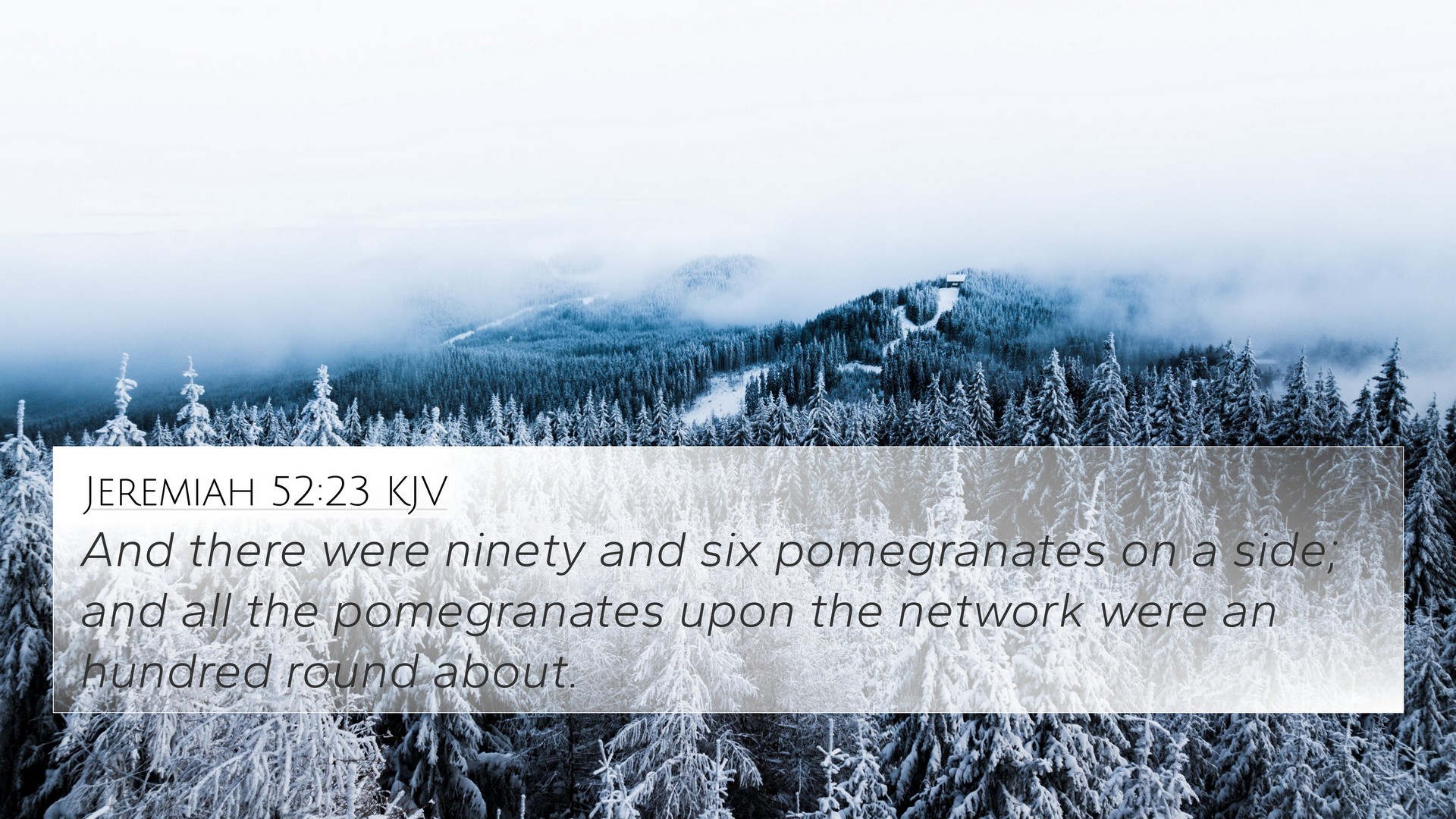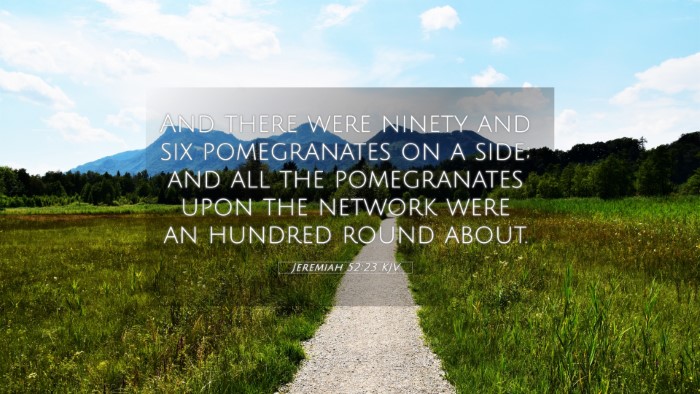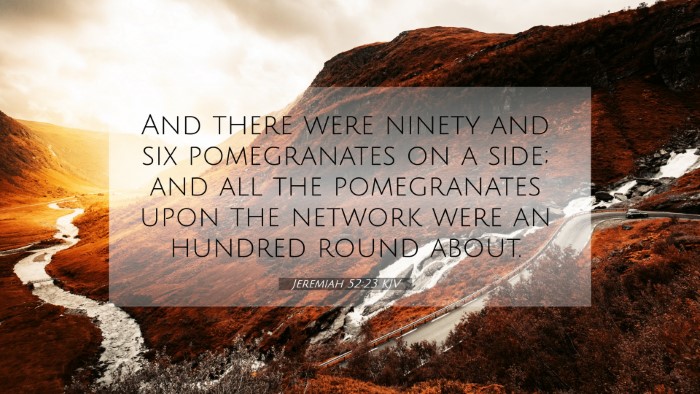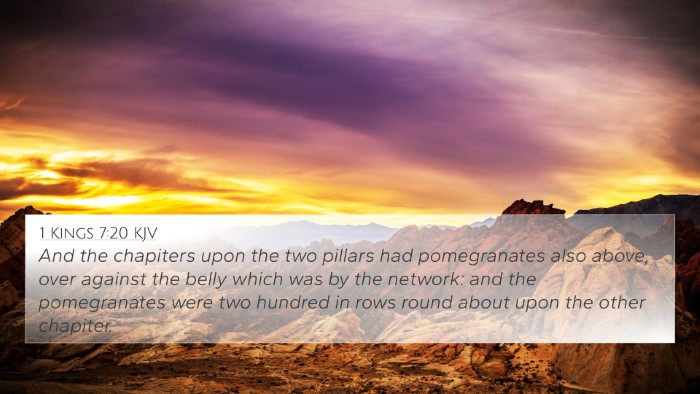Interpretation of Jeremiah 52:23
Verse Reference: Jeremiah 52:23 states, "And there were ninety and six pomegranates on a side; and all the pomegranates upon the network were an hundred round about."
This verse concludes the description of the bronze pillars in the Temple, noting the decorative elements that symbolize abundance and the beauty of the temple. The detailed counting of the pomegranates is significant in conveying both aesthetic and spiritual meanings.
Summary of Insights from Public Domain Commentaries
-
Matthew Henry's Commentary: Henry emphasizes the artistic and symbolic nature of the pomegranates. They represent fertility and prosperity, which might reflect God's blessings upon His people. The specific number, ninety-six, suggests a completeness in design, indicative of divine order in everything related to the temple.
-
Albert Barnes' Notes: Barnes elaborates on the architectural significance of the pomegranates. He notes that pomegranates were commonly used in sacred design throughout the ancient Near East. The inclusion of these fruits implies a connection to the themes of life and abundance, reinforcing the temple's role as a place of divine presence and blessing.
-
Adam Clarke's Commentary: Clarke draws attention to the cultural relevance of pomegranates in Biblical texts, linking them with the concept of fruitfulness in a covenant relationship with God. He suggests that each pomegranate on the network symbolizes the prosperity that comes from faithfulness to God, thus enriching the understanding of the temple's purpose as a dwelling for the Divine in the midst of His people.
Bible Verse Cross-References
This verse can be cross-referenced with several others to explore broader Biblical themes and connections:
- Exodus 28:33-34: Mentions pomegranates as part of the High Priest's robe, symbolizing beauty and holiness.
- 1 Kings 7:18-20: Discusses similar pomegranate decorations in the temple, showing their significance in sacred architecture.
- Song of Solomon 4:3: Compares a beloved to a pomegranate, emphasizing themes of desire and beauty.
- Deuteronomy 8:8: Talks about the land of promise having abundant fruits, including pomegranates, representing divine provision.
- Numbers 13:23: The spies brought back pomegranates as evidence of the fruitfulness of the Promised Land.
- Revelation 22:2: Describes the tree of life bearing twelve kinds of fruits, suggesting eternal abundance and the fulfillment of divine promises.
- Proverbs 3:9-10: Ties themes of honoring God with wealth to the promise of abundance and overflow, reminiscent of the pomegranates' symbolism.
Connections Between Bible Verses
The connections among these verses reveal a thematic thread regarding God's provision, promise, and the representation of abundance in Biblical imagery. Cross-referencing these texts enables a deeper understanding of how motifs such as fruitfulness and divine presence are woven throughout Scripture.
Thematic Bible Verse Connections
Further exploring the interconnectedness of Biblical texts can reveal profound insights into themes such as:
- Fruitfulness: Seen throughout the Bible as a symbol of God's blessing—manifested in both personal and communal contexts.
- Divine Presence: The temple as a dwelling place of God serves as a culmination point of His relationship with His people, illustrated through its intricate designs.
- Beauty and Holiness: The aesthetic elements of the temple echo the beauty of God's creation and His call to holiness among His people.
Tools for Bible Cross-Referencing
To effectively study these connections and understand how they illuminate various aspects of Christian faith, consider using tools such as:
- Bible concordances to find themes and locate similar verses.
- Cross-reference Bible study guides for structured study paths.
- Comprehensive Bible cross-reference materials for in-depth exploration.
- Online resources and apps that facilitate verse linking and thematic studies.
Comparative Bible Verse Analysis
Engaging in comparative studies between verses can yield insights into how different authors treat similar themes. For example:
- Comparing the use of pomegranates in temple worship with their mention in the Song of Solomon reveals the dual nature of relationships—both with God and among people.
- Analyzing the significance of abundance in Deuteronomy compared to Revelation emphasizes God's unchanging nature in His promises.
Interpreting Biblical Themes Through Cross-References
Understanding Jeremiah 52:23 in the context of other Scriptures enhances appreciation for the rich tapestry of God's communication to humanity. It encourages believers to see the continuity of themes such as:
- Trust in God's provision through seasons of both abundance and lack.
- The call to holiness and beauty in our worship, inspired by His divine order.
- Recognition of how tangible symbols in the temple connect to the ultimate Spirit of worship, embodied in Jesus Christ.



